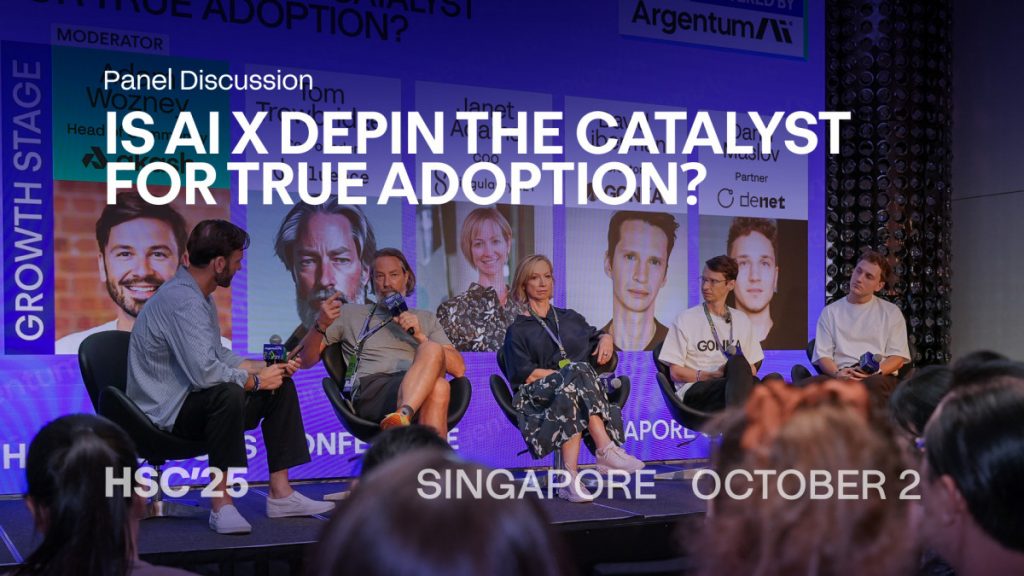Decentralized Infrastructure And AI Convergence: Unlocking Scalable Web3 Adoption At Hack Seasons Singapore


In Brief
The Hack Seasons Singapore conference panel explored how the convergence of AI and DePIN could drive practical crypto adoption, enhance Web3 usability, and more.

At the beginning of October, Hack Seasons held its latest conference in Singapore, bringing together industry experts to examine key developments across the crypto, AI, and Web3 sectors. One of the notable sessions on the growth stage, focused on project evolution and practical experience, was the panel titled “Is AI x DePIN the Catalyst for True Adoption.”
The discussion, moderated by Adam Wozney, Head of Community at Akash Network, featured Tom Trowbridge, Co-Founder of Fluence, Janet Adams, COO at SingularityNET, David Liberman, Creator of Gonka, and Daniil Maslov, Partner at DeNET. The panel explored how the convergence of artificial intelligence and decentralized physical infrastructure networks (DePIN) could drive the next phase of meaningful adoption across the digital ecosystem.
The panel opened with a discussion on the convergence of two major technological trends: the exponential demand for AI infrastructure and the rise of DePIN. As AI continues to require unprecedented levels of computing power, storage, and energy, DePIN presents a scalable, community-powered alternative capable of meeting these needs through a decentralized, permissionless model. The conversation centered on whether this intersection could finally give cryptocurrency a practical utility that extends beyond speculation and into everyday use, or whether mainstream adoption remains premature.
Panelists examined the meaning of true cryptocurrency adoption and whether AI and DePIN possess a distinct advantage in driving it compared to other blockchain-based innovations. They emphasized that adoption can take multiple forms — from users holding digital assets to those engaging with blockchain-based infrastructure without necessarily owning tokens like Bitcoin or Ethereum. DePIN projects, both physical and virtual, were described as a bridge toward broader adoption, with real-world applications already gaining traction. Participants noted that many users are already interacting with decentralized infrastructure, often without realizing it, suggesting that the transition toward widespread use is further along than generally perceived.
Speakers also discussed the technological strengths that give cryptocurrency an edge, particularly zero-knowledge proofs and advanced privacy and security capabilities. As global concerns around data protection and regulatory compliance intensify, these features were identified as areas where decentralized networks can outperform centralized computing systems. The growing trend of open-sourcing large language models (LLMs) and deep neural networks (DNNs) was highlighted as another factor accelerating AI adoption on blockchain. Open-sourcing, they noted, enhances model efficiency and reduces computational complexity, paving the way for the deployment of LLMs on decentralized networks with stronger privacy safeguards. In parallel, the continued evolution of neuro-symbolic AI — which combines neural learning with symbolic reasoning — is expected to align naturally with decentralized infrastructures. As institutional participation increases and regulatory clarity improves, the intersection of crypto, AI, and DePIN is anticipated to experience rapid expansion.
Panelists further explored how the existing cryptocurrency infrastructure could be leveraged to power AI development. They noted that blockchain networks already represent a vast, distributed computing base, with Bitcoin alone estimated to operate at 26 gigawatts of global computing capacity — surpassing the combined infrastructure of major technology companies. This, they suggested, positions crypto as a ready-made foundation for decentralized AI systems. The anticipated deployment of application-specific integrated circuits (ASICs) in decentralized AI networks, expected to begin in the coming year, could significantly accelerate this shift, creating compute systems orders of magnitude larger than current centralized setups while maintaining strong security standards.
The discussion continued with an examination of what true mass adoption might look like in practice. Panelists emphasized that mainstream users are unlikely to adopt Web3 technologies simply because they are decentralized. The key, they argued, lies in making Web3 applications as seamless and intuitive as their Web2 counterparts, so that users engage with decentralized systems without needing to understand the underlying technology. Lowering entry barriers, improving user experience, and ensuring that security and reliability are built into the system were identified as essential steps toward this goal. Similarly, achieving developer-level adoption will require decentralized infrastructure to match centralized services in accessibility and performance. Only when choosing between decentralized and centralized systems becomes effortless for both users and developers, the panelists concluded, will the industry achieve true mass adoption.
Powering The Future: How DePIN And AI Could Redefine Cloud Infrastructure Via Decentralization
The panel continued by addressing one of the key constraints in decentralized infrastructure: power availability. Participants noted that energy remains the primary limiting factor in scaling these networks and examined how well DePIN are positioned to compete with centralized cloud providers. While DePIN is not expected to replace traditional cloud computing in the near future, panelists agreed that capturing even a small portion—around 10 percent—of the global cloud market would represent an achievement. The objective, they emphasized, is not to replicate or directly rival providers like Amazon Web Services, but to offer targeted, specialized alternatives for select use cases where decentralization provides unique advantages.
Speakers also pointed to broader paradigm shifts emerging in both hardware utilization and AI development. These shifts are expected to enable decentralized finance (DeFi) systems to outperform traditional financial infrastructure across numerous applications, allowing value and profits to remain within decentralized ecosystems rather than centralized intermediaries. The fast advancement of AI, which continues to multiply its capabilities annually, was cited as another key driver of decentralization. Centralized compute providers are limited by their internal resources, while decentralized networks can draw on a vast, open pool of global talent and innovation. Thousands of new algorithmic approaches are being developed and tested across distributed systems every week, creating an environment where algorithms evolve and compete at a pace that centralized entities cannot match. This convergence of AI and blockchain technology was viewed as a major step toward realizing the foundational ideals of decentralization envisioned by early cryptography pioneers.
The panel agreed that the opportunity extends far beyond market share. The decentralized model was described as inherently better suited for fostering hardware innovation and efficiency improvements. Continuous innovation, rather than scale alone, was identified as the key to driving exponential progress. The focus now lies in redirecting technological and creative energy toward transferring computational power from centralized players to decentralized communities, ultimately creating a network that could surpass existing systems in both capacity and resilience.
Speakers also highlighted security as one of DePIN’s strongest advantages. Decentralized systems inherently reduce single points of failure and provide greater transparency and resilience compared to centralized infrastructures. However, they acknowledged that achieving mainstream recognition and large-scale adoption will take time. Building public awareness and trust, they noted, remains a crucial step before decentralized networks can begin to compete meaningfully with established cloud providers.
The discussion concluded with a forward-looking perspective on what needs to occur over the next three years for AI and DePIN to be recognized as major catalysts for cryptocurrency adoption. The panel agreed that continued technological progress, growing institutional participation, and measurable real-world applications will be essential to proving that this convergence can deliver lasting, practical value beyond speculative use.
Disclaimer
In line with the Trust Project guidelines, please note that the information provided on this page is not intended to be and should not be interpreted as legal, tax, investment, financial, or any other form of advice. It is important to only invest what you can afford to lose and to seek independent financial advice if you have any doubts. For further information, we suggest referring to the terms and conditions as well as the help and support pages provided by the issuer or advertiser. MetaversePost is committed to accurate, unbiased reporting, but market conditions are subject to change without notice.
About The Author
Alisa, a dedicated journalist at the MPost, specializes in cryptocurrency, zero-knowledge proofs, investments, and the expansive realm of Web3. With a keen eye for emerging trends and technologies, she delivers comprehensive coverage to inform and engage readers in the ever-evolving landscape of digital finance.
More articles

Alisa, a dedicated journalist at the MPost, specializes in cryptocurrency, zero-knowledge proofs, investments, and the expansive realm of Web3. With a keen eye for emerging trends and technologies, she delivers comprehensive coverage to inform and engage readers in the ever-evolving landscape of digital finance.


















































